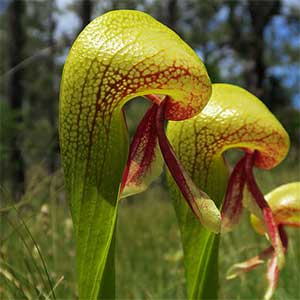Darlingtonia californica
Darlingtonia
California pitcher plant, cobra lily, cobraplant
California pitcher-plant, cobra-lily, cobra-plant, pitcher plant, plant
with white areolae, 4–6(–10) dm, neck ca. 1 cm.
persistent, erect, monomorphic, twisted through 90–270°, yellowish green, often suffused with red, distally enlarging into globose head, firm, surfaces glabrous;
orifice round, facing ground, not covered by hood;
hood arising adaxially on rim of orifice, pendulous, fishtail-shaped, flattened or slightly twisted, 2-lobed, lobes widely divergent laterally from pitcher axis, yellowish green to reddish, base narrowed to neck, apex acute to rounded.
absent.
5–10 dm;
bracts yellowish, 1–3.5 cm.
1, slightly longer to much longer than pitchers;
bracts usually 9, alternate along scape, clasping, erect or spreading, lanceolate, apex acute.
sepals yellow-green, 3–6 cm;
petals reddish brown with larger veins darker, 3.5 cm;
stamens 10 mm;
filaments 5 mm;
abaxial anther sacs 6 mm, adaxial ones 4 mm;
ovary 1.5 × 0.5 cm at base, to 1.3 cm diam. at apex;
style 5 mm, lobes 3 × 1 mm.
odorless;
sepals persistent, lance-ovate to oblanceolate, margins entire, apex acute;
petals deciduous, touching, forming curtain surrounding stamens and pistil, pendulous, ovate, each notched beyond middle (distally) so that indentations of adjacent petals align forming 5 holes in corolla, margins entire, apex acuminate;
stamens 15, distinct;
filaments uniform in length;
anthers basifixed;
ovary turbinate, shallowly 10-lobed, apex depressed;
style terminal, arising from depressed apex of ovary, terminating in 5 radially diverging, filiform arms covered with stigmatic cells laterally.
3.5–4.5 × 1–2.5 cm.
obconic, finely tuberculate, acropetally dehiscent.
2–3 × 1 mm.
ca. 1000, long-clavate, not keeled, long-papillate.
= 15.
= 30.
Darlingtonia californica
Darlingtonia
Within California, Darlingtonia californica is disjunct from Del Norte County in the northwest to Nevada County southeasterly in the Sierra Nevada, and introduced in Humboldt and Mendocino counties. In Oregon, it occurs in the coastal lowlands and inland mountains of Curry and Josephine counties northward to Tillamook County. It is introduced on Vancouver Island in British Columbia, and in southern Washington. It may form relatively large stoloniferous colonies on mountain slopes or meadows and in coastal lowlands, or in shallow streams and seepage bogs. The flowers are initiated in the fall and overwinter in the bud stage, protected by the bracts. The fruits mature in late summer to fall, with seed dispersal continuing throughout the winter. The long papillae on the seeds allow flotation.
Darlingtonia californica is stunning in the wild, eagerly sought for cultivation, and difficult to grow outside its cool native range. It was discovered in 1841 on the Wilkes Expedition by the assistant botanist, W. D. Brackenridge, growing in a marsh bordering a tributary on the Sacramento River south of Shasta Peak. It is currently threatened by road building, draining, logging, ranching, drought, and unscrupulous collectors. Darlingtonia and some eastern American species of carnivorous plants have been transplanted into sites in northern California and the Pacific Northwest.
(Discussion copyrighted by Flora of North America; reprinted with permission.)
Chrysamphora Greene
Species 1: nw North America.
Species 1
(Discussion copyrighted by Flora of North America; reprinted with permission.)


